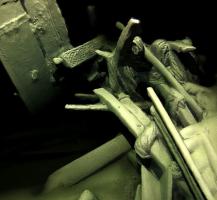
Stern of the Ottoman-era ship showing coils of rope and a tiller with elaborate carvings. Photo: Expedition and Education Foundation/Black Sea MAP
Recently, the New York Times featured an article on 40 recently discovered wooden shipwrecks located deep in the Black Sea off the Bulgarian coast. In age, the wrecks span a millennium, from the ninth to the 19th centuries. What is so amazing about these wrecks is how well they are preserved. Intricate carving in the wood and even coils of rope have survived for many centuries underwater. The cold, dark, and a lack of oxygen has protected the wrecks from the organisms that would normally eat away at the wood and other natural materials on the ancient ships.
The Black Sea is not alone in its ability to preserve wooden vessels. In North America, the dark and oxygen free waters of the deeper sections of the Great Lakes has also effectively protected shipwrecks. Recently, Smithsonian described the newly discovered 1884 wreck of J.S. Seaverns, which is said to be perfectly preserved. Likewise the Baltic is known for its well preserved shipwrecks.
Somewhat bizarrely, while the wooden ships in the Baltic and the Great Lakes have remained relatively pristine, an iconic steel ship, the RMS Titanic is literally being devoured by a recently identified species of rust-eating bacteria. The iron-oxide-munching bacterium, discovered by researchers at Dalhousie University in Halifax, Nova Scotia, has fittingly been named Halomonas titanicae. Recent estimates predict that by the year 2030 the ship may be completely consumed by the bacteria.
“In 1995, I was predicting that Titanic had another 30 years,” Dalhousie scientist Henrietta Mann said. “But I think it’s deteriorating much faster than that now. Perhaps if we get another 15 to 20 years out of it, we’re doing good … eventually there will be nothing left but a rust stain.”
The Titanic lies on the ocean floor over 2 miles beneath the surface. At that depth the water is cold, dark and oxygen scarce. How is it possible for the Halomonas titanicae not only to lie in such extreme conditions but also to devour a large steel ship? The Human Touch of Chemistry blog explains:
Deep sea water is quite poor in oxygen. Bacteria that live there often depend upon oxides of metals to obtain oxygen. They do this by breaking up the oxygen to yield metal atoms and oxygen atoms. The metal is a waste product for the bacteria, while they use the oxygen for respiration. Halomonas titanicae uses rust (which is a mixture of iron oxides) as a source of oxygen.
Halomonas titanicae is one of thousands of bacteria species called extremeophiles, because they live in extreme environments. This one lives in doubly extreme conditions. Deep below the sea surface, the pressure is very high, and it’s also very salty.

The Bulgarian coast of the Baltic Sea? Try to find that on Google maps please
Hi Rick. Something is not right with this story. Bulgaria is on the Black Sea. Perhaps the conditions in the Black Sea are the same as in the Baltic for preserving old ships. Keep up the good work. I really enjoy the daily posts. Roger
So if Bulgaria is on the Black Sea or the well preserved wrecks there or in the Baltic? Well spotted Roger! Really enjoy the daily posts too!
While Authorities are still investigating these disappearances:
Maybe these same conditions exist in the Java Sea off of the coast of
Indonesia, enabling the mysterious disappearance of those WWII vessels.
My fingers wer faster than my brain. I associate well preserved shipwrecks with the Baltic, whereas the NY Times article was indeed about the Black Sea. My screw up entirely. I fixed the post.
My screw-up entirely. I fixed the post.
My screw-up. I fixed it.
Maybe Rick didn’t make s mistake, but knows something about Putin using Bulgaria in a secret plan to take out Poland and Lithuania….